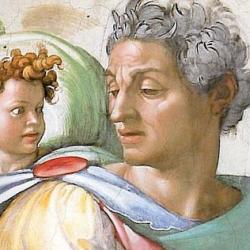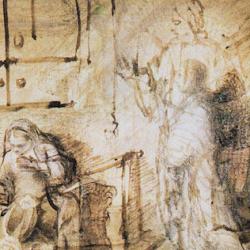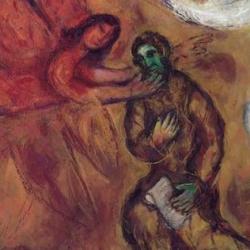In a 1993 essay in JSOT , David Carr summarizes some of the recent work on the unity of Isaiah. In contrast to the scholarship of the last couple of centuries, contemporary scholars are focusing on the signs of compositional and literary unity in the book.
He points, for instance, to the very tradition division of the book at the end of Isaiah 39. After 39 chapters that focus on Jerusalem’s bloodguilt, promising forgiveness and expiation but never making good on that promise, Isaiah 40 begins with an announcement of forgieness linked with a return from Babylonian exile.
The contrast of the two sections is evident in the contrasting parallels between Isaiah 6, the prophet’s call, and Isaiah 40, which serves as a renewal and recasting of the call:
“Point by point, the commission report in Isa. 40.1-8 parallels 6.1-13, even as it sets a decisive new tone for the following part of the book. In Isa. 6.6-7 a seraph pronounces Isaiah’s sins ‘turned away’ and his bloodguilt ‘atoned for’, while in Isa. 40.1-2 all of Zion/Jerusalem experiences this same process. In 6.3 the seraphim sang praises to God’s glory, a glory that fills the earth. In 40.5 the new exodus allows ‘all flesh’ to see God’s glory. Then, just as Isaiah was commissioned to bring a message of judgment in 6.8-10, so 40.6-8 describes the commissioning of a figure to bring the message of the new exodus.”
The mission of the prophet, however, has changed: “Whereas Isaiah was commissioned in ch. 6 (6.9) to ‘see and not understand’, God’s servant in chs. 40 and following (especially 42.7) is commissioned to ‘open the eyes of the blind’; the judging ‘holy one of Israel’ of Isaiah 1-39 becomes a saving ‘holy one of Israel’ in 40-66; Jerusalem is no longer being punished and purged as in 1-39, but is restored in chs. 40 and following. Furthermore, this overall transition from judgment to restoration seems to be thematized in the body of chs. 40-48 through several texts that refer to ‘former things’ (Isa. 41.21-23; 42.9; 43.9-12; 44.6-8; 45.21-22; 46.9-11; 48.3-8; cf. 43.19).”
Further, there are thematic inclusions surrounding the book: At the beginning and end, Isaiah condemns Israel’s liturgical sins, says that wrongdoers will be “put to shame,” and predicts the separation of the righteous and the wicked.
Carr, unfortunately, ends up arguing that these literary signs of unity are less than they seem. He argues, for instance, that, despite the parallels between chapter 1 and chapters 65-66, they differ in the way the present the choice between righteousness and wickedness. This is absurd, of course; isn’t it possible – likely, in fact – that there would be some progression of thought in a book as lengthy and complex as Isaiah?














